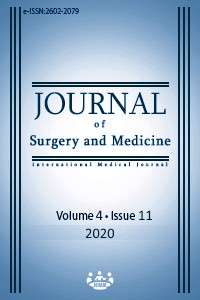Evaluation of risk factors for surgical site infection after cesarean section
Keywords:
cesarean, risk factors, surgical site infectionAbstract
Aim: Surgical site infection after cesarean section is an important and common health issue. Although there are several studies researching risk factors in the literature, limited data is present evaluating these factors in the Turkish population. In this study, we aimed to determine the risk factors and provide management protocols for the Turkish population. Methods: In this retrospective case-control study, 76 patients between 16-45 years of age who underwent cesarean section and were hospitalized for surgical site infection within 6 weeks and 149 patients who had no postpartum infection between June 2016 and December 2017 were included. Sociodemographic features, laboratory parameters, comorbid diseases and surgical characteristics were recorded. SPSS 21.0 was used for statistical analysis and P-value <0.05 was considered statistically significant. Results: The rate of surgical site infection requiring hospitalization was 1% (76/7590). In the infection positive group, body mass index and fasting blood glucose levels were higher (P<0.001 and P=0.021). Moreover, preoperative hemoglobin was lower and surgery time was longer in this group (P<0.001 and P=0.005). In logistic regression analysis, the risk of surgical site infection was found to increase by 1.4-fold with increased body mass index (OR 1.463, 95%CI 1.273-1.681, P<0.001) and 1.2-fold with higher fasting glucose level (OR 1.21, 95%CI 1.16-1.37, P=0.007). Patients with shorter surgery time (OR 0.749, 95%CI 0.709-0.789, P=0.010) and high preoperative hemoglobin levels (OR 0.532, 95%CI 0.408-0.695, P<0.001) had decreased infection risk. Conclusion: The risk factors of surgical site infection after cesarean section are generally modifiable. Thus, healthcare providers should inform patients for postpartum infection and risk factors during pregnancy and eliminate these factors if possible.
Downloads
References
Hamilton BE, Martin JA, Osterman MJK, Curtin SC, Matthews TJ. Births: Final Data for 2014. National Vital Statistics Reports, vol. 64, no. 12. National Center for Health Statistics: Hyattsville, MD, USA, 2015.
Haidar ZA, Nasab SH, Moussa HN, Sibai BM, Blackwell SC. Caesarean Delivery Surgical Site Infection: What are Expected Rates and Potentially Modifiable Risk Factors? J Obstet Gynaecol Can. 2018;40(6):684-9. doi: 10.1016/j.jogc.2017.09.020.
Castillo E, McIsaac C, MacDougall B, Wilson D, Kohr R. Post-Caesarean Section Surgical Site Infection Surveillance Using an Online Database and Mobile Phone Technology. J Obstet Gynaecol Can. 2017;39(8):645-51.
Blumenfeld YJ, El-Sayed YY, Lyell DJ, Nelson LM, Butwick AJ. Risk factors for prolonged post partum length of stay following cesarean delivery. Am J Perinatol. 2015;32(9):825–32.
Horan TC, Andrus M, Dudeck MA. CDC/NHSN surveillance definition of healthcare–associated infection and criteria for specific types of infections in the acute care setting. Am J Infect Control. 2008;36:309–32.
Olsen MA, Butler AM, Willers DM, Devkota P, Gross GA, Fraser VJ. Risk factors for surgical site infection after low transverse cesarean section. Infect Control Hosp Epidemiol. 2008;29(6):477–84.
Kawakita T, Landy HJ. Surgical site infections after cesarean delivery: epidemiology, prevention and treatment. Maternal Health Neonatology and Perinatology. 2017;3:12.
Johnston RC, Gabby L, Tith T, Eaton K, Westermann M, Wing DA. Immediate postpartum glycemic control and risk of surgical site infection. The Journal of Maternal-Fetal & Neonatal Medicine. 2016;30(3):267-71.
Horan TC, Gaynes RP, Martone WJ, Jarvis WR, Emori TG. CDC definitions of nosocomial surgical site infections, 1992; A modification of CDC definitions of surgical wound infections. Infection Control Hosp Epidemiol. 1992;13:606-8.
Stamilio DM, Scifres CM. Extreme obesity and post cesarean maternal complications. Obstet Gynecol. 2014;124:227–32.
Vermillion ST, Lamoutte C, Soper DE, Verdeja A. Wound infection after cesarean: effect of subcutaneous tissue thickness. Obstet Gynecol. 2000;95:923–6.
Subramaniam A, Jauk VC, Figueroa D, Biggio JR, Owen J, Tita ATN. Risk factors for wound disruption following cesarean delivery. J Matern Fetal Neonatal Med. 2014;27:1237–40.
Dotters-Katz SK, Feldman C, Puechl A, Grotegut CA, Heine RP. Risk factors for post-operative wound infection in the setting of chorioamnionitis and cesarean delivery. J Matern Fetal Neonatal Med. 2016;29(10):1541-5.
Takoudes TC, Weitzen S, Slocum J, Malee M. Risk of cesarean wound complications in diabetic gestations. Am J Obstet Gynecol. 2004;191:958–63.
Chaim W, Bashiri A, Bar-David J, Shoham-Vardi I, Mazor M. Prevalence and Clinical Significance of Postpartum Endometritis and Wound Infection. Infectious Diseases in Obstetrics and Gynecology. 2000;8:77-82.
Latham R, Lancaster AD, Covington JF, Pirolo JS, Thomas CS. The association of diabetes and glucose control with surgical-site infections among cardiothoracic surgery patients. Infect Cont Hosp Epidemiol. 2001;22:607–12.
Gordillo GM, Sen CK. Revisiting the essential role of oxygen in wound healing. Am J Surg. 2003;186:259–63.
Guzman MA, Prien SD, Blann DW. Post-cesarean related infection and vaginal preparation with povidone-iodine revisited. Primary Care Update OB/GYNS 2002;9(6):206–9.
Wodajo S, Belayneh M, Gebremedhin S. Magnitude and Factors Associated With Post-Cesarean Surgical Site Infection at Hawassa University Teaching and Referral Hospital, SouthernEthiopia: A Cross-sectional Study. Ethiop J Health Sci. 2017;27:283-90.
Opoien HK, Valbo A, Grinde-Andersen A, Walberg M. Post-cesarean surgical site infections according to CDC standards: rates and risk factors. A prospective cohort study. Acta Obstet Gynecol Scand. 2007;86:1097–102.
Jido TA, Garba ID. Surgical-site Infection following cesarean section in Kano, Nigeria. Ann Med Health Sci Res. 2012;2:33–6.
Mpogoro FJ, Mshana SE, Mirambo MM, Kidenya BR, Gumodoka B, Imirzalioglu C. Incidence and predictors of surgical site infections following caesarean sections at Bugando Medical Centre, Mwanza, Tanzania. Antimicrob Resist Infect Control. 2014;3:25.
Gong S, Guo H, Zhou H, Chen L, Yu Y. Morbidity and risk factors for surgical site infection following cesarean section in Guangdong Province, China. Obstet Gynecol Res. 2012;38:509-15.
National Collaborating Centre for Women's and Children's Health (UK), author Prevention and treatment of surgical site infection: NICE Clinical Guidelines. London: RCOG Press; 2008. pp. 45–55.
Downloads
- 746 1007
Published
Issue
Section
How to Cite
License
Copyright (c) 2020 Burcu Dinçgez Çakmak, Betül Dündar, Ülkü Turker, Muzaffer Temür, Hacer Özdemir, Emin Üstünyurt, Gülten Özgen
This work is licensed under a Creative Commons Attribution-NonCommercial-NoDerivatives 4.0 International License.
















